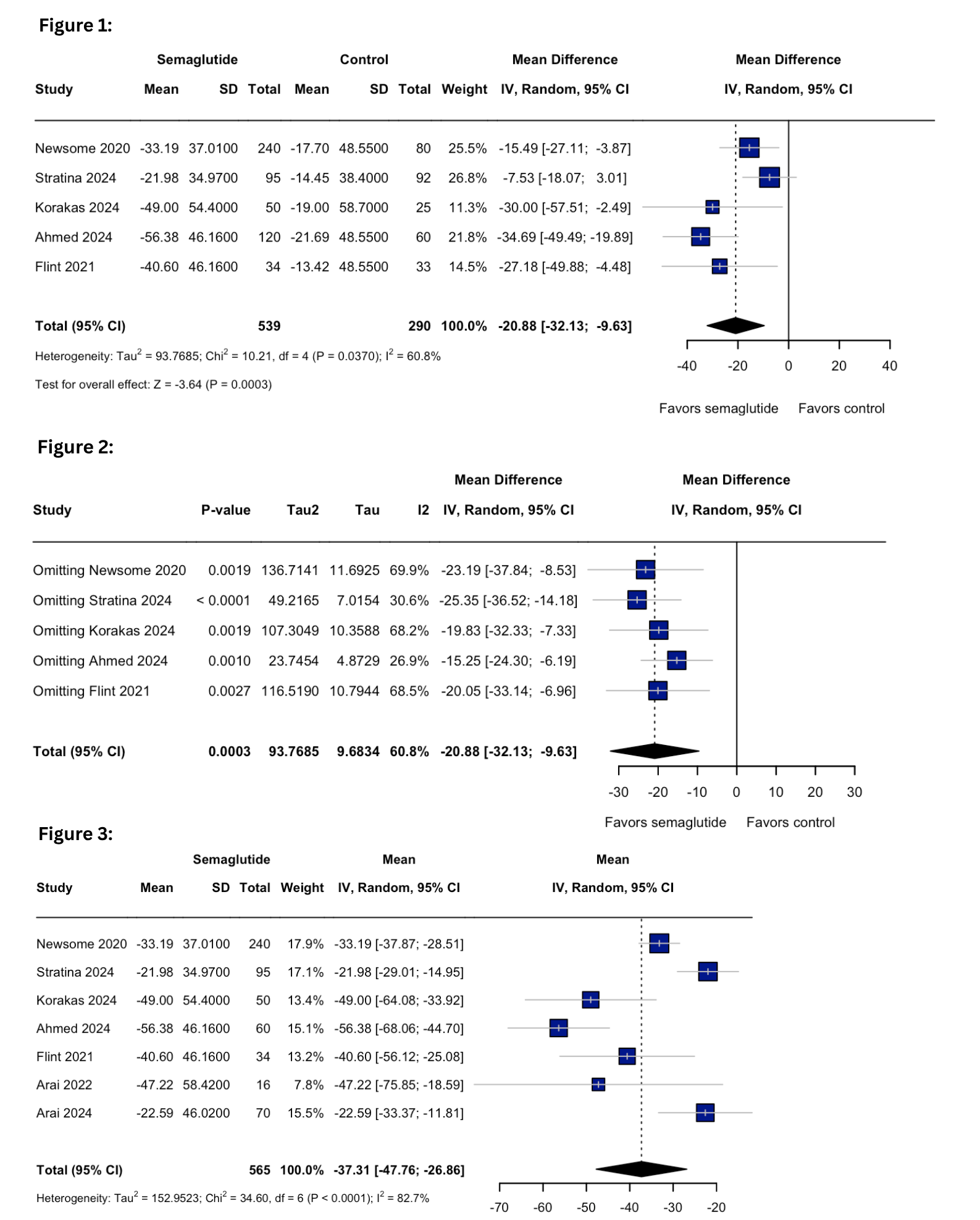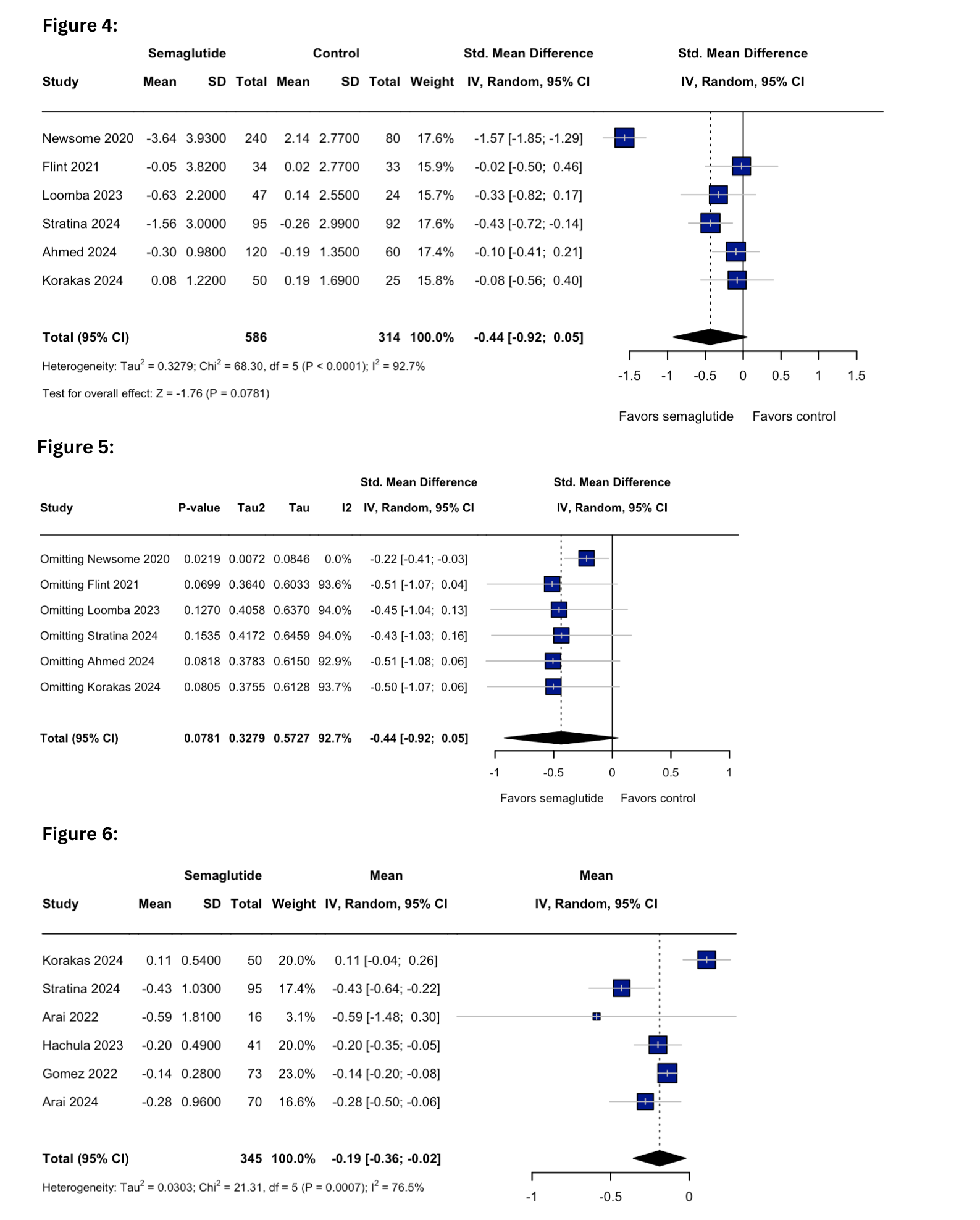Sunday Poster Session
Category: Liver
P1558 - Safety and Efficacy of Semaglutide in Metabolic Dysfunction-Associated Steatotic Liver Disease (MASLD) and Metabolic Dysfunction-Associated Steatohepatitis (MASH): A Systematic Review and Meta-Analysis
Sunday, October 26, 2025
3:30 PM - 7:00 PM PDT
Location: Exhibit Hall
- DG
Dewan Giri, MBBS (he/him/his)
University of Florida Health Shands Hospital
Gainesville, FL
Presenting Author(s)
Faseeh Haider, MD1, Adnan Bhat, MD2, Muhammad Ansab, 3, Arun Kumar. Maloth, MBBS4, Sufyan Shahid, MBBS5, Ahmad Khan, 6, Zaryab Bacha, 7, Abdullah Afridi, 7, Saeed Aftab Khan, 8, Fatima Binte Athar, MBBS9, Omar Al-Radideh, MD10, Dewan Giri, MBBS11
1Allama Iqbal Medical college, Lahore, Punjab, Pakistan; 2University of Florida, Gainesville, FL; 3Services Institute of Medical Sciences, Lahore, Punjab, Pakistan; 4Kakatiya Medical College, Warangal, India, Warangal, Telangana, India; 5Khawaja Muhammad Safdar Medical College, Sialkot, Punjab, Pakistan; 6Khyber Medical University, Peshawar, North-West Frontier, Pakistan; 7Khyber Medical College, Peshawar, North-West Frontier, Pakistan; 8Allama Iqbal Medical College, Lahore, Punjab, Pakistan; 9Karachi Medical And Dental College, Karachi, Sindh, Pakistan; 10University of Florida College of Medicine, Gainesville, FL; 11University of Florida Health Shands Hospital, Gainesville, FL
Introduction: Semaglutide, a GLP-1 receptor agonist, has demonstrated potential in improving liver and metabolic outcomes. However, there is inconclusive data regarding its role in reducing hepatic steatosis and fibrosis in metabolic dysfunction-associated steatotic liver disease (MASLD) and metabolic dysfunction-associated steatohepatitis (MASH). This systematic review and meta-analysis aimed to assess the safety and efficacy of semaglutide in patients with MASLD and its progressive form, MASH.
Methods: We conducted a comprehensive search of PubMed, Embase, Cochrane, Scopus, ClinicalTrials.gov, and ScienceDirect to retrieve interventional trials evaluating the use of semaglutide in MASLD or MASH. Outcomes included changes in controlled attenuation parameter (CAP) score, liver stiffness, liver enzymes (ALT/AST), fibrosis scores (FIB-4), body mass index (BMI), hemoglobin A1c (HbA1c), and cholesterol levels. Both double- and single-arm meta-analyses were performed using a random-effects model in R, with sensitivity analyses and publication bias assessments.
Results: 13 studies comprising 1,334 patients were included. In comparative analyses, semaglutide significantly reduced hepatic steatosis (CAP score: Mean Difference [MD] −20.88 dB/m; p=0.0003), BMI (MD −2.17 kg/m²; p=0.0004), HbA1c (MD −1.32%; p=0.0004), ALT (MD −12.16 U/L; p< 0.0001), and AST (MD −10.00 U/L; p=0.008). Liver stiffness reduction was non-significant initially (Standardized Mean Difference [SMD] −0.44; p=0.078), but achieved significance upon the exclusion of an outlier, i.e., Newsome et al. 2020 (SMD −0.22; p=0.022; I² = 0%).
In single-arm analysis, semaglutide significantly improved CAP (MD −37.31 dB/m; p< 0.001), FIB-4 (MD −0.19; p=0.03), BMI (MD −3.19 kg/m²; p< 0.001), HbA1c (MD −1.00%; p< 0.001), ALT (MD −19.32 U/L; p< 0.001), and AST (MD −12.80 U/L; p< 0.001). Cholesterol reduction was significant in single-arm studies (MD −14.55 mg/dL; p=0.018) but not in comparative data (MD −3.00 mg/dL; p=0.738). Heterogeneity ranged from moderate to high across most outcomes but was addressed through sensitivity analyses. Publication bias was minimal to moderate.
Discussion: Semaglutide significantly improves hepatic steatosis and metabolic parameters in patients with MASLD/MASH. However, its effect on fibrosis is limited and inconsistent, underscoring the need for longer trials that utilize histological endpoints. Semaglutide may be most beneficial in MASLD patients with diabetes mellitus or obesity as part of a broader therapeutic strategy.

Figure: Graphic 1
Figure 1: Forest Plot of the pooled CAP score in double-arm studies
Figure 2: Sensitivity analysis of the pooled CAP score in double-arm studies
Figure 3: Forest Plot of the pooled CAP score in single-arm studies

Figure: Graphic 2
Figure 4: Forest Plot of the liver stiffness in double-arm studies
Figure 5: Sensitivity analysis of the liver stiffness in double-arm studies
Figure 6: Forest Plot of the pooled FIB-4 score in single-arm studies
Disclosures:
Faseeh Haider indicated no relevant financial relationships.
Adnan Bhat indicated no relevant financial relationships.
Muhammad Ansab indicated no relevant financial relationships.
Arun Maloth indicated no relevant financial relationships.
Sufyan Shahid indicated no relevant financial relationships.
Ahmad Khan indicated no relevant financial relationships.
Zaryab Bacha indicated no relevant financial relationships.
Abdullah Afridi indicated no relevant financial relationships.
Saeed Aftab Khan indicated no relevant financial relationships.
Fatima Binte Athar indicated no relevant financial relationships.
Omar Al-Radideh indicated no relevant financial relationships.
Dewan Giri indicated no relevant financial relationships.
Faseeh Haider, MD1, Adnan Bhat, MD2, Muhammad Ansab, 3, Arun Kumar. Maloth, MBBS4, Sufyan Shahid, MBBS5, Ahmad Khan, 6, Zaryab Bacha, 7, Abdullah Afridi, 7, Saeed Aftab Khan, 8, Fatima Binte Athar, MBBS9, Omar Al-Radideh, MD10, Dewan Giri, MBBS11. P1558 - Safety and Efficacy of Semaglutide in Metabolic Dysfunction-Associated Steatotic Liver Disease (MASLD) and Metabolic Dysfunction-Associated Steatohepatitis (MASH): A Systematic Review and Meta-Analysis, ACG 2025 Annual Scientific Meeting Abstracts. Phoenix, AZ: American College of Gastroenterology.
1Allama Iqbal Medical college, Lahore, Punjab, Pakistan; 2University of Florida, Gainesville, FL; 3Services Institute of Medical Sciences, Lahore, Punjab, Pakistan; 4Kakatiya Medical College, Warangal, India, Warangal, Telangana, India; 5Khawaja Muhammad Safdar Medical College, Sialkot, Punjab, Pakistan; 6Khyber Medical University, Peshawar, North-West Frontier, Pakistan; 7Khyber Medical College, Peshawar, North-West Frontier, Pakistan; 8Allama Iqbal Medical College, Lahore, Punjab, Pakistan; 9Karachi Medical And Dental College, Karachi, Sindh, Pakistan; 10University of Florida College of Medicine, Gainesville, FL; 11University of Florida Health Shands Hospital, Gainesville, FL
Introduction: Semaglutide, a GLP-1 receptor agonist, has demonstrated potential in improving liver and metabolic outcomes. However, there is inconclusive data regarding its role in reducing hepatic steatosis and fibrosis in metabolic dysfunction-associated steatotic liver disease (MASLD) and metabolic dysfunction-associated steatohepatitis (MASH). This systematic review and meta-analysis aimed to assess the safety and efficacy of semaglutide in patients with MASLD and its progressive form, MASH.
Methods: We conducted a comprehensive search of PubMed, Embase, Cochrane, Scopus, ClinicalTrials.gov, and ScienceDirect to retrieve interventional trials evaluating the use of semaglutide in MASLD or MASH. Outcomes included changes in controlled attenuation parameter (CAP) score, liver stiffness, liver enzymes (ALT/AST), fibrosis scores (FIB-4), body mass index (BMI), hemoglobin A1c (HbA1c), and cholesterol levels. Both double- and single-arm meta-analyses were performed using a random-effects model in R, with sensitivity analyses and publication bias assessments.
Results: 13 studies comprising 1,334 patients were included. In comparative analyses, semaglutide significantly reduced hepatic steatosis (CAP score: Mean Difference [MD] −20.88 dB/m; p=0.0003), BMI (MD −2.17 kg/m²; p=0.0004), HbA1c (MD −1.32%; p=0.0004), ALT (MD −12.16 U/L; p< 0.0001), and AST (MD −10.00 U/L; p=0.008). Liver stiffness reduction was non-significant initially (Standardized Mean Difference [SMD] −0.44; p=0.078), but achieved significance upon the exclusion of an outlier, i.e., Newsome et al. 2020 (SMD −0.22; p=0.022; I² = 0%).
In single-arm analysis, semaglutide significantly improved CAP (MD −37.31 dB/m; p< 0.001), FIB-4 (MD −0.19; p=0.03), BMI (MD −3.19 kg/m²; p< 0.001), HbA1c (MD −1.00%; p< 0.001), ALT (MD −19.32 U/L; p< 0.001), and AST (MD −12.80 U/L; p< 0.001). Cholesterol reduction was significant in single-arm studies (MD −14.55 mg/dL; p=0.018) but not in comparative data (MD −3.00 mg/dL; p=0.738). Heterogeneity ranged from moderate to high across most outcomes but was addressed through sensitivity analyses. Publication bias was minimal to moderate.
Discussion: Semaglutide significantly improves hepatic steatosis and metabolic parameters in patients with MASLD/MASH. However, its effect on fibrosis is limited and inconsistent, underscoring the need for longer trials that utilize histological endpoints. Semaglutide may be most beneficial in MASLD patients with diabetes mellitus or obesity as part of a broader therapeutic strategy.

Figure: Graphic 1
Figure 1: Forest Plot of the pooled CAP score in double-arm studies
Figure 2: Sensitivity analysis of the pooled CAP score in double-arm studies
Figure 3: Forest Plot of the pooled CAP score in single-arm studies

Figure: Graphic 2
Figure 4: Forest Plot of the liver stiffness in double-arm studies
Figure 5: Sensitivity analysis of the liver stiffness in double-arm studies
Figure 6: Forest Plot of the pooled FIB-4 score in single-arm studies
Disclosures:
Faseeh Haider indicated no relevant financial relationships.
Adnan Bhat indicated no relevant financial relationships.
Muhammad Ansab indicated no relevant financial relationships.
Arun Maloth indicated no relevant financial relationships.
Sufyan Shahid indicated no relevant financial relationships.
Ahmad Khan indicated no relevant financial relationships.
Zaryab Bacha indicated no relevant financial relationships.
Abdullah Afridi indicated no relevant financial relationships.
Saeed Aftab Khan indicated no relevant financial relationships.
Fatima Binte Athar indicated no relevant financial relationships.
Omar Al-Radideh indicated no relevant financial relationships.
Dewan Giri indicated no relevant financial relationships.
Faseeh Haider, MD1, Adnan Bhat, MD2, Muhammad Ansab, 3, Arun Kumar. Maloth, MBBS4, Sufyan Shahid, MBBS5, Ahmad Khan, 6, Zaryab Bacha, 7, Abdullah Afridi, 7, Saeed Aftab Khan, 8, Fatima Binte Athar, MBBS9, Omar Al-Radideh, MD10, Dewan Giri, MBBS11. P1558 - Safety and Efficacy of Semaglutide in Metabolic Dysfunction-Associated Steatotic Liver Disease (MASLD) and Metabolic Dysfunction-Associated Steatohepatitis (MASH): A Systematic Review and Meta-Analysis, ACG 2025 Annual Scientific Meeting Abstracts. Phoenix, AZ: American College of Gastroenterology.
